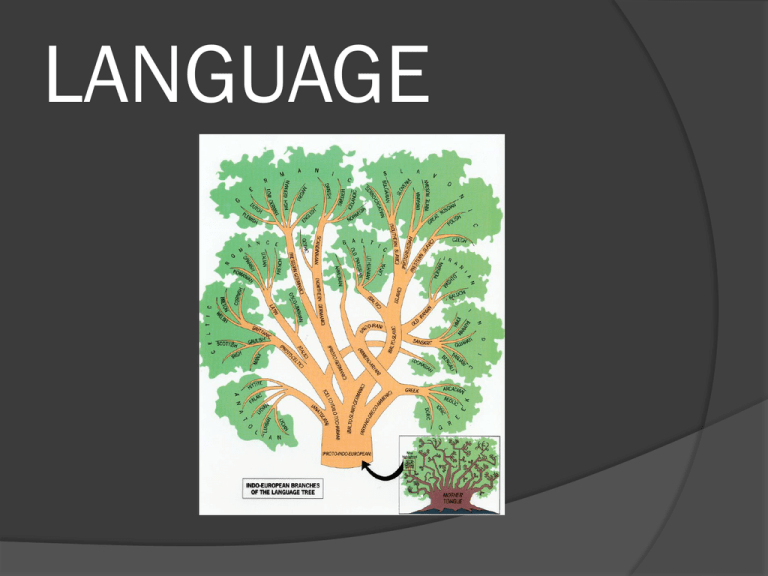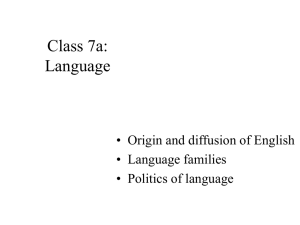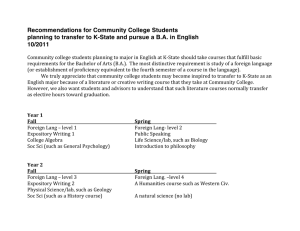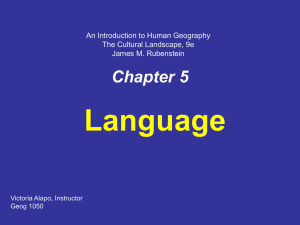LANGUAGE
advertisement

LANGUAGE Language Introduction Language is critical because it’s the means by which other cultural values are communicated United Nations 6 official languages: Russian French Chinese Spanish English Arabic Discussion Prompt: Thirty U.S. states have passed laws mandating English as the language of all government functions. Should the use of English be encouraged in the United States to foster cultural integration, or should bilingualism be encouraged to foster cultural diversity? Dialects of English Dialects: regional variation of a language distinguished by distinctive vocabulary, spelling, and pronunciation Ex: Southerners say ya’ll, Australians say “mate” American and British English = different dialects Differ because of isolation – evolved independently during 18th and 19th C Dialects of English – cont’d Noah Webster created 1st American dictionary, wanted unique American dialect to increase national pride Dialects of English – Con’t Webster……. Ex: substituted “s” for “c” in many words (“defence” to “defense”) Ex: eliminated “u” from words like “honour” and “colour” Changed pronunciation Dialects of English – cont’d Dialects within the US – existed originally because of differences in dialects among original settlers Dialects continue today mostly in the east (especially in the South and New England) Isogloss: word usage boundary for any word not used nationally (ex: pop, ya’ll, hoagie) Dialects become less prominent because of mobility Soda v. Pop Dialect Examples of Regional Vocabulary ALLIGATOR PEAR An avocado in New Orleans. BETTY A beauty in Los Angeles. BUBBLER A drinking fountain in Wisconsin. BUGGY A shopping cart in the South. BULKIE A sandwich roll in Boston. CABINET A milkshake in Rhode Island. FRAPPE A milkshake in Boston. GAPER'S BLOCK A traffic jam because of rubbernecking in Chicago. GOOBER A peanut in the South. HOT DISH A casserole in Wisconsin and Minnesota. IRON DOG A snowmobile in Alaska. JIMMIES Ice cream sprinkles in Boston. KITTY-WAMPUS Cater-corner in Wisconsin. NEB To nose into someone else's business in Pittsburgh. PARTY BARN A drive-through liquor store in Texas. POKE A bag in Pittsburgh. ROTARY A traffic circle in New England. SHOOTS O.K. in Hawaii. SKROK To spit in Buffalo. STAND ON LINE To stand in line in New York. WALLERED Useless or wrecked in the Southwest. WOOLIES Dustballs beneath your bed in Pennsylvania Northern Virginia Vocabulary Are there any words that are used in NOVA that may be unique? Language Families All language belong to a family – collection of many languages which come from same original tongue, long ago, before written history but have since evolved with different characteristics (i.e. have same ancestor) Indo-European Family I-E family = largest family…spoken by over 50% of world Families divided into smaller branches and groups I-E as 8 branches, 4 BIG ones Germanic Branch: dominant in N and W Europe (Swedish, Dutch, Danish, English, Norwegian) Indo-European Family – cont’d Indo-Iranian Branch: branch w/ most speakers (over 100 lang spoken by over 1 bill people) ○ Indic (Eastern) Group: India, Pakistan, Bangladesh (Hindi, Urdu) ○ Iranian (Western) Group: Iran, Afghanistan (Persian, Kurdish, Pathan) Indo-European Family – cont’d Balto Slavic Branch – Russian, Ukrainian, Polish, Czech, Slovak, Bulgarian Romance Branch evolved from Latin spoken by Romans 2,000 yrs ago. Conquering Romans diffused their lang through the empire. After fall of empire, regions were isolated and lang developed distinctly Indo-Euro Lang Family Tree Indo-Euro Family – most widely diffused language Pidgins and Creole Languages When 2 groups meet with different languages, a new language with new characteristics of both emerges. Pidgin: simplified form of lingua Franca (usually forms as a simple trade language); no native speakers; used for communication among speakers of 2 diff. languages (i.e. hodge podge combination - ex. African slaves) Creole: language combined between colonizers and colonized/indigenous peoples - blended ○ Ex: French Creole in Haiti Indo-European Ancestor? Called Proto-Indo-European – difficult to prove because existed thousands of yrs before written history. 2 theories…. Kurgan Hearth: Russia/Kazakhstan, N. of Black Sea, spread by nomadic herders Anatolian Hearth: present day Turkey – spread by farmers Other Lang Families Indo-European – 50% Sino Tibetan – 20% (Chinese, Cantonese, Thai) Afro-Asiatic 5% - Middle East – Arabic, Hebrew Niger-Congo 5% - Africa (Africa – most diverse languages…unknown #. Over 1,000 distinct lang and several thousand dialects. Nigeria alone has over 200 distinct lang. Austroneasean – 5% SE Asia Dravidian 5% - parts of India Global Language Families Language Preservation Distribution of a language is a measure of the fate of an ethnic group. Language displays the 2 competing geographic trends: GLOBALIZATION Versus LOCAL DIVERSITY Language Extinction No longer in use by any living people Thousands have become extinct over history but process has accelerated in recent past Colonialism in 18th and 19th C and globalization of 20th C driven many lang to extinction Ex: when Spanish arrive in Amazon found over 500 lang. Today 57 survive, half of which will die in next few yrs as elderly speakers pass away Language Extinction – cont’d Pressures of econ and social acculturation responsible for today’s extinction (i.e. adoption of cultural traits like lang by one group under the influence of another) Lang extinction can lead to cultural extinction: an entire culture obliterated by war, disease, acculturation. When a culture and its language disappear it takes w/ it a tremendous amount of history Language Extinction “To lose my mother tongue would be like being forced into language exile. I would lose my family’s history and culture.” - James Jansen – director of “In Language We Live” – documentary on extinct languages Language Extinction Language Revival Movements to revive near extinct language Parts of Scotland, Ireland, Wales – revive Celtic Hebrew revived after WW II when Israel became a state. Hebrew made one of two official languages (with Arabic). Due to the fact that Hebrew was used primarily for religious services and was not commonly spoken. (Official language: all government business occurs in this language – schools, documents, road signs, etc.) Official Languages…. Language given a unique status in the constitution of countries Government makes a declarative statement Typically language used in nation’s legislative bodies Over half the countries in the world have official languages Some have one; others have more than one USA doesn’t have an official language….should we? Official Languages Multi Lingual States Have multiple official languages – can cause difficulty Belgium- Walloons in S speak French, Flemings in N speak Flemish. Language boundary sharply divides country. Each region has own elected assembly that runs their region and often antagonism between the two. Multi Lingual States CANADA – French and English. Quebec has had separatist movement in past. Separation only voted down by slim majority Multi Lingual States Basques – Pyrenees mountains in N. Spain, ETA – separatist movement – engaged in terrorist attacks





